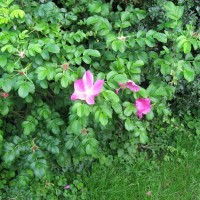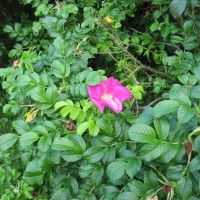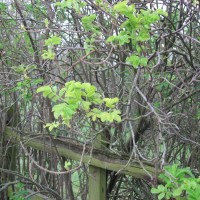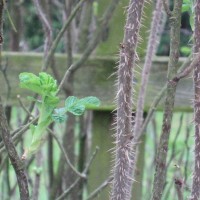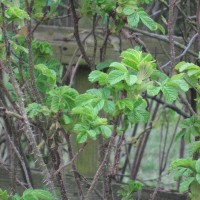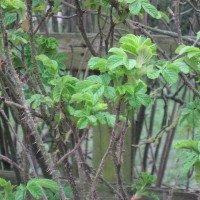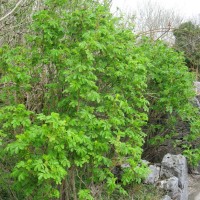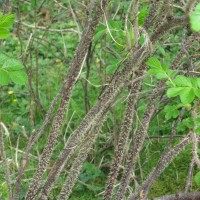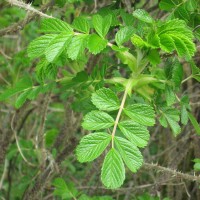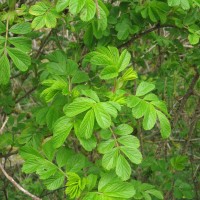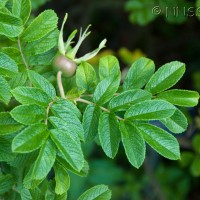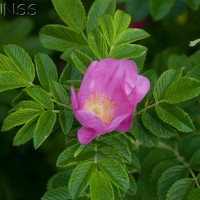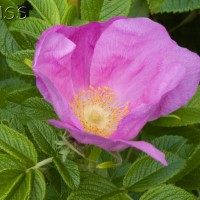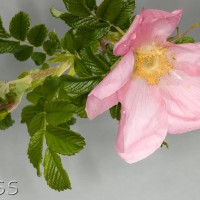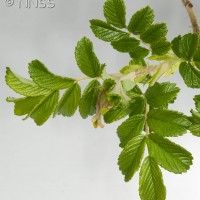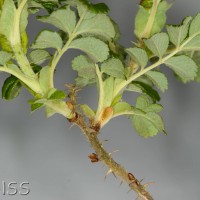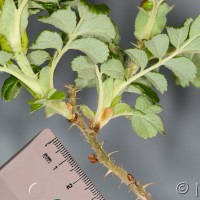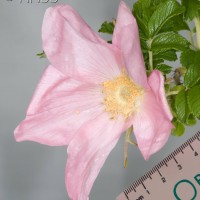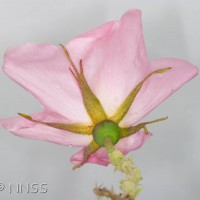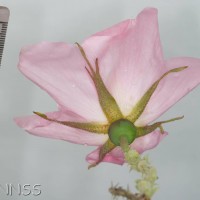
Japanese Rose - Rosa rugosa
Expand and collapse the sections below by clicking on the title or + / - icons.
Short description of Rosa rugosa, Japanese Rose
A multi-stemmed deciduous 'Dog Rose'. Stems with dense straight prickles of various sizes. Leaves wrinkled above, greyish-downy beneath. Flowers large, usually solitary and vivid purplish-pink. Hips large, red when ripe, somewhat flattened in profile and often drooping when ripe.
Impact summary: Rosa rugosa, Japanese Rose
In habitats most resembling those of its native range (dunes, coastal vegetated shingle and well-drained acid grassland) it can form dense thickets, competing with native vegetation, sometimes to its total exclusion. Elsewhere its spread is usually limited.
Habitat summary: Rosa rugosa, Japanese Rose
In its native range, coastal dune grassland and scrub (especially yellow dunes), coastal vegetated shingle, free-draining acid grassland, and to a lesser extent tall-herb meadow communities, road verges and waste ground.
Overview table
| Environment | Terrestrial |
|---|---|
| Species status | Non-Native |
| Native range | Russian Far East, China, Eastern Asia |
| Functional type | Land plant |
| Status in England | Non-Native |
| Status in Scotland | Non-Native |
| Status in Wales | Non-Native |
| Location of first record | v.c.74 (Monreith, Wigton) |
| Date of first record | 1917 |
Origin
Native to the coasts of Japan, Korea, north-east China, and far eastern Russia at low altitudes.
First Record
Introduced into GB in 1796 but only generally established in gardens after its re-introduction in the 1870s. First recorded in the wild at Keswick, Cumberland in 1927.
Pathway and Method
Brought from Asia to Europe on several occasions and under several names. As a garden plant it is grown in its own right and used for breeding and as a grafting stock. Undoubtedly introduced deliberately or as a throw-out into the wild in some locations but also spreading by natural means.
Species Status
Distribution mapping suggests a huge spread in GB in the late 20th century but in part this is an artefact of more thorough recording. It is widely naturalised in Northern Europe, particularly well established and similarly invasive in coastal regions of the Baltic and North Sea but also occurring far inland in Germany.
Dispersal Mechanisms
Hips are attractive to small mammals and birds, and birds are an important long-distance vector. Hips are also known to be buoyant in salt water for long periods, and marine currents are thought to be an important mechanism in Scandinavia. Once established, local spread is by suckering and populations occupying several hectares are known.
Reproduction
Pollen viability is high; selfing is now known to occur as well as cross-fertilisation. Several hybrids are known from the wild, including three from GB. On average a hip contains about 60 seeds with 85-95% viability.
Known Predators/Herbivores
Birds (especially thrushes) and perhaps small mammals take the hips. A wide range of insects feeds on Japanese rose, but it appears less susceptible to attack than most native Rosa species.
Resistant Stages
Mature plants are resistant to burning, surviving by its rhizomes, as well as low temperatures, high soil salinity and drought. Large herbivores graze young but not well-developed shoots. Japanese Rose has high resistance to black spot and powdery mildew. Seeds pass unscathed through frugivorous birds such as thrushes, but are mostly destroyed by seed-eaters like finches.
Habitat Occupied in GB
Coastal sand and vegetated shingle, grassland and low scrub, verges and waste ground.
Throughout GB from the extreme South to the Shetlands, generally avoiding heavier soils and the uplands, and with concentrations in some coastal and peri-urban areas.
Environmental Impact
Japanese Rose is capable of forming dense thickets where few other higher plant species can grow, even outcompeting relatives with similar habitat requirements such as Burnet Rose. It can invade valued natural and semi-natural habitats.
Its abundant pollen is a valuable food source chiefly to bumble-bees. There is an unquantified benefit as a food source to Thrushes which may be important during autumn and winter movements.
Roots are known to sequester pollutants, particularly heavy metals.
Health and Social Impact
There are no documented health hazards for this species. Dense thickets may limit recreational access. Hips are a rich source of vitamin C but there appears to be no significant organised exploitation in Europe.
Economic Impact
Invasion into valued habitats entails costs for conservation land managers, especially as burning, mowing and spraying of aerial parts are not effective. The annual cost of controlling this species in Sweden has been estimated rather crudely at between 100,000 and 1.5 million euros.
Identification
Stace, C.A. (2010) New flora of the British Isles, Third Edition, Cambridge University Press, Cambridge.
Graham, G.G. (1993) Roses of Great Britain and Ireland, BSBI Handbook No. 7, BSBI, London.
Biology, ecology, spread, vectors
Bruun, H.H. (2005) Rosa rugosa Thunb. ex Murray, Biological Flora of the British Isles No. 239, Journal of Ecology, 93, 441-470.
Fremstad, E. (1997) Fremmede planter i Norge. Rynkerose - Rosa rugosa, Blyttia, 55, 115-121.
Jessen, K. (1958) Om vanspredning af Rosa rugosa og andre arter af sloegten., Bot. Tidsskr., 54, 353-367.
Preston, C.D., Pearman, D.A. & Dines, T.D. (2002) New Atlas of the British and Irish Flora, Oxford University Press, Oxford.
Management and impact
Bruun, H.H. (2006) Prospects for biocontrol of invasive Rosa rugosa. BioControl, 51, 141-181.
General
Weidema, I. (2006) NOBANIS – Invasive Alien Species Fact Sheet – Rosa rugosa. From: Online Database of the North European and Baltic Network on Invasive Alien Species – NOBANIS www.nobanis.org, Date of access 16/02/2011
Spotted this species?
Distribution map
View the Distribution map for Japanese Rose, Rosa rugosa from BSBI
ID Sheet
ID Sheet for Rosa rugosa . See a full list of non-native species ID Sheets.
Legislation
This species is listed under Schedule 9 of the Wildlife and Countryside Act 1981. Read more about Non-native species legislation.

